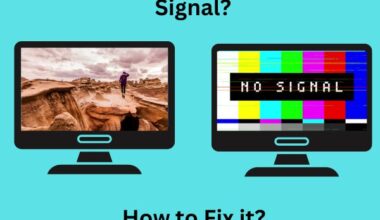Have you ever been on a Zoom video call, only to realize your face looks like it has been inside the oven?
The zoom app has solved the problem of virtual meetings and remote collaboration, but one thing it is yet to solve is to make you look better onscreen.
However, the main culprit is the lighting in your room. The poor lighting makes your face appear dark, shadowy, or even washed-out and tired.
Carefully playing with lighting will help achieve the soft yet crisp look you often find in professional streamers’ video streaming.
Read on to find the best tips for lighting setup for Zoom on a reasonable budget.
Table of Contents Show
How to Get the Best Lighting Setup For Zoom?
When you launch the Zoom application, does a mysterious, shadowy figure appear on the screen?
“Yikes, gotta fix the lighting,” saying aloud as you rush to find the spot with good lighting or fumble with a lamp.
This scenario will sound familiar to many people.
Although it may suffice when talking to your friends or family, it will leave a wrong impression on your colleagues and clients.
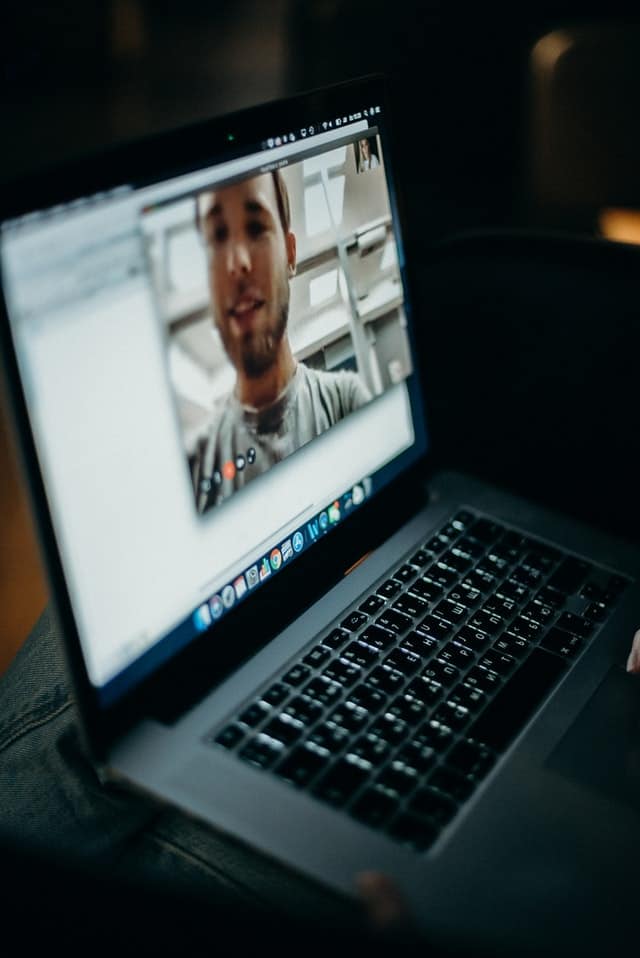
Unfortunately, Zoom or any other video calling app does not offer any lighting option to fix the problem; therefore, your only solution is to improve the lighting.
We have scoured the internet to find some proven and affordable ways to get the best lighting setup for Zoom.
1. Use Natural Light
One of the easiest ways to score great lighting is sunlight.
Natural lighting provides full spectrum illumination that brightens your face and prevents eye strain from artificial lighting.
Moreover, it is the most budget-friendly best lighting option.
- Sit a few feet from the window to illuminate your front side to look your best.
- Use a drape or curtain to offset the harsh sunlight. The indirect lighting fills in all the hard edges to create a perfect sync with the background.
- Sit close to the window during the latter part of the day to get the best of limited sunlight.
If possible, you can place your home office desk facing the window to get enough natural light.
2. Use Artificial Lighting
You cannot always rely on natural lighting for illumination when Zoom calls. What if it is evening or night?
The best solution is to set up artificial lighting so you can video call anytime at the same spot.
Every professional streamer and YouTuber relies on indoor lighting, usually LED, to create a perfect lighting setup.
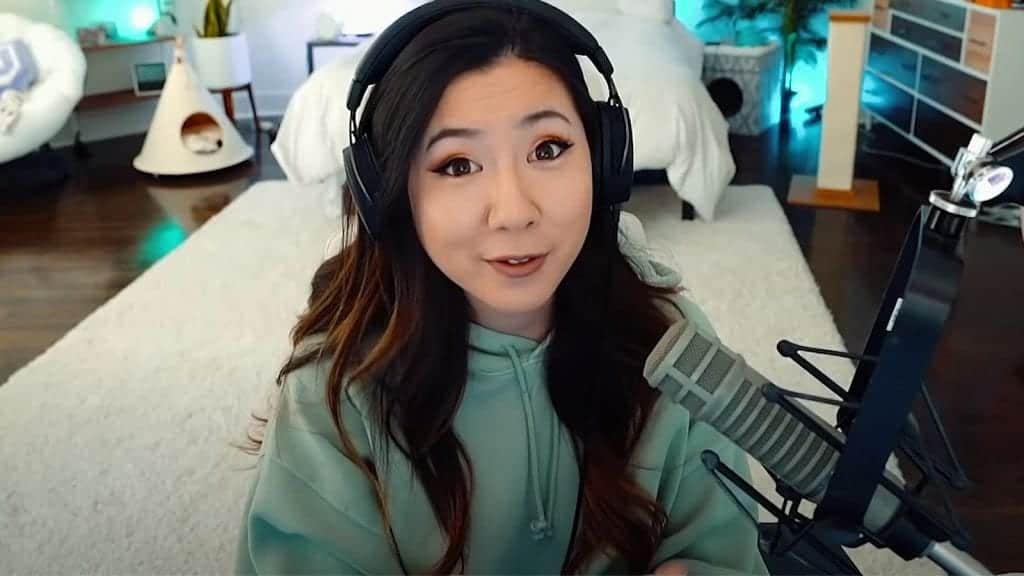
However, it would be best to be wary about light fixtures and luminance.
Type of Artificial Lighting
1. Ambient Lighting
Ambient lighting is a constant light source that illuminates the entire room but may not provide suitable lighting for Zoom calls.
Ceiling LED lights and wall LED lights are two primary ambient lighting sources that help evenly brighten the entire space.
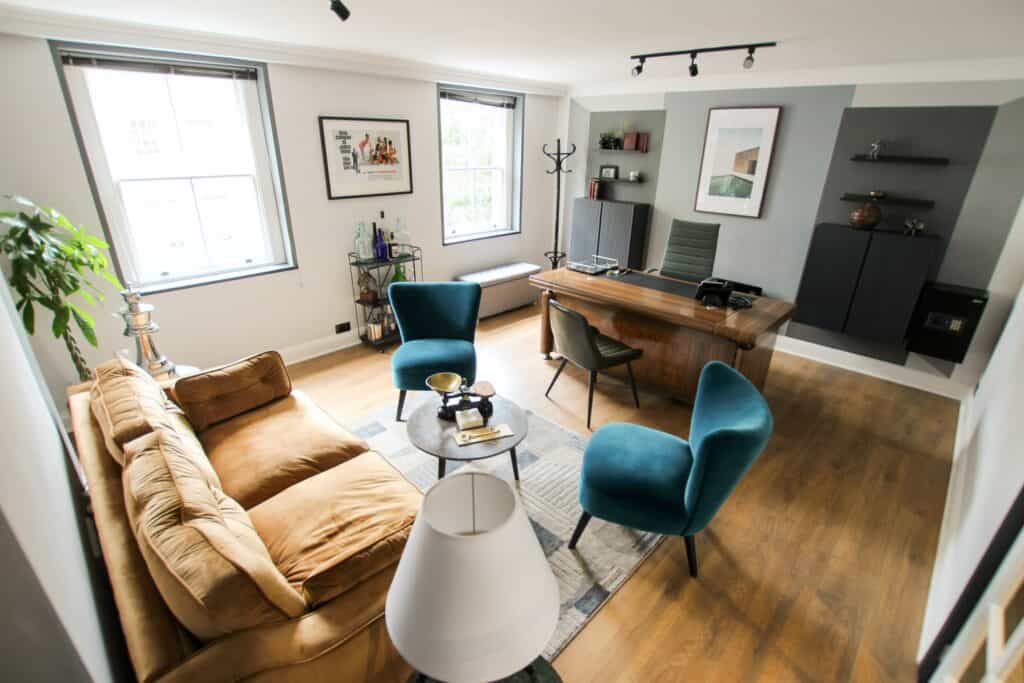
Sit either facing the ambient light source or away from it. Avoid sitting directly under the ambient lighting, creating shadows on your face.
Natural daylight also offers ambient lighting that you can aptly use during the day.
Here are a few recommendations.
| Ambient Light | Specification | Price |
|---|---|---|
| Metalux LED Drop Ceiling Troffer Light | 5,000 lumens fantastic for general-purpose, ambient commercial, or household lighting | $51.48 |
| Nuvo 65/1091 LED Ceiling Wrap, White | LED ceiling wrap light, 1600 lumens | $41.99 |
2. Task Lighting
Task lighting is the focused light source that provides intense illumination.
As the term suggests, task lighting illuminates a task or specific area to create a well-lit condition. It would be the most crucial lighting for video calling.
Some task lighting examples include desk-mounted lamps, ring lights, focus lamps, and portable lighting kits.
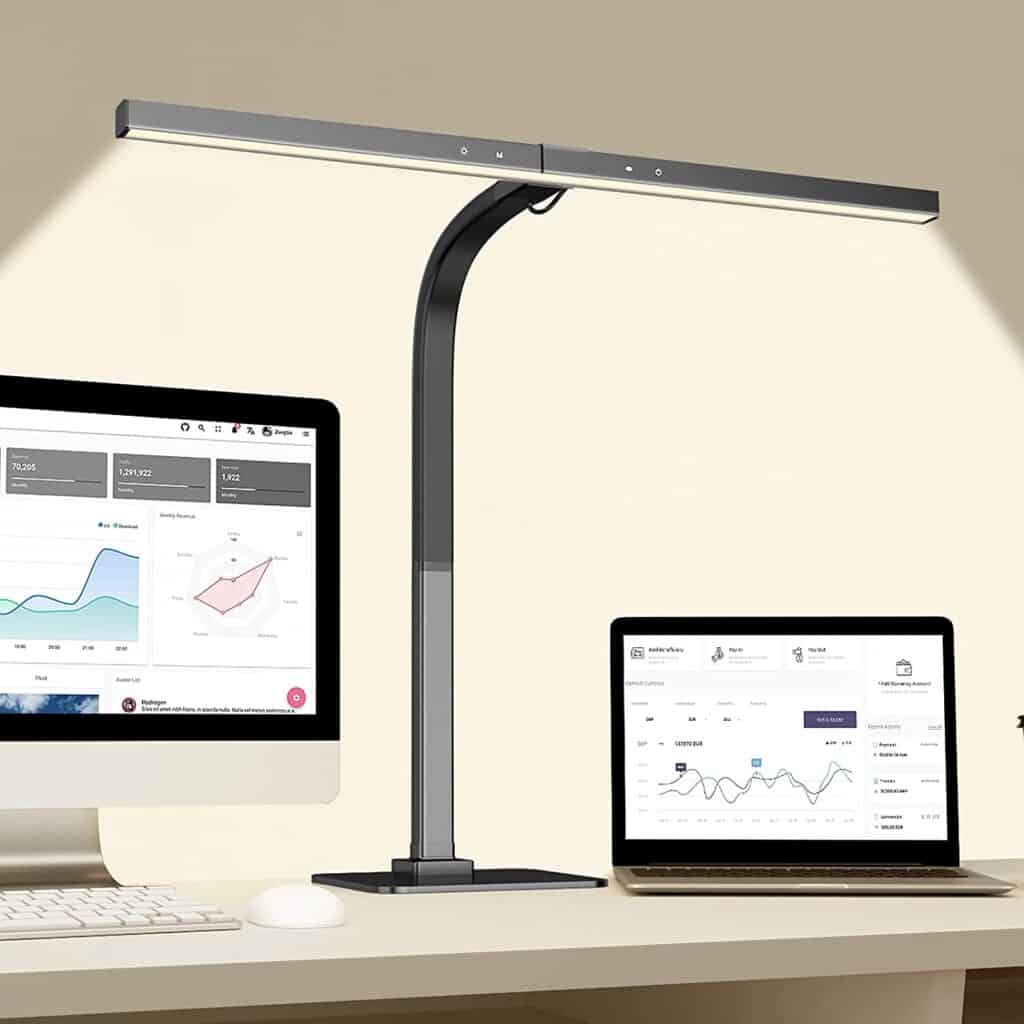
Using ring light gives the bright, crisp image many TikTok Stars use. It also provides excellent lighting to your face and highlights your eyes.
Here are a few recommendations.
| Task Light | Specification | Price |
|---|---|---|
| ESDDI 18-inch ring light | 100W 18inch right light with adjustable color temperature | $84.99 |
| Dexter Modern Desk Lamp | USB connected 60 watt desk lamp | $169.96 |
| UBeesize LED Video Light Kit | Professional lighting kit for photo and videography | $39.99 |
3. Accent Lighting
Accent lighting is additional lighting that contributes to a lighting layer to create depth.
Wall lights, ceiling pendants, shelves light, etc., are a few examples of accent lighting that adds layers to a video image.
However, accent lighting will not provide ample brightness for video calls. Instead, you can use it to create an optimistic mood in the background.
Here are a few recommendations.
| Accent Light | Specification | Price |
|---|---|---|
| 6-pack LED track lighting | Wall Art Exhibition Lighting 6 (3000K Warm White) | $89.99 |
| Mini accent light | Mini accent light with 12V | $143.95 |
| Hybrid 2 Accent Lighting | Accent lighting for wall and shelf decoration | $88.74 |
B. Luminance and Color
The best lighting setup for video calls has appropriate luminance, warm color temperature, and ample brightness.
1. Diffused Light
When setting up lighting for a video meeting, choose diffused, over-concentrated or harsh light to create an evenly lit subject.
Soft or diffused light gives a natural look by reducing glare, which is a less eye-straining experience for other participants.
Use a lampshade or diffuser; get an adjustable light fixture to reduce harsh light.
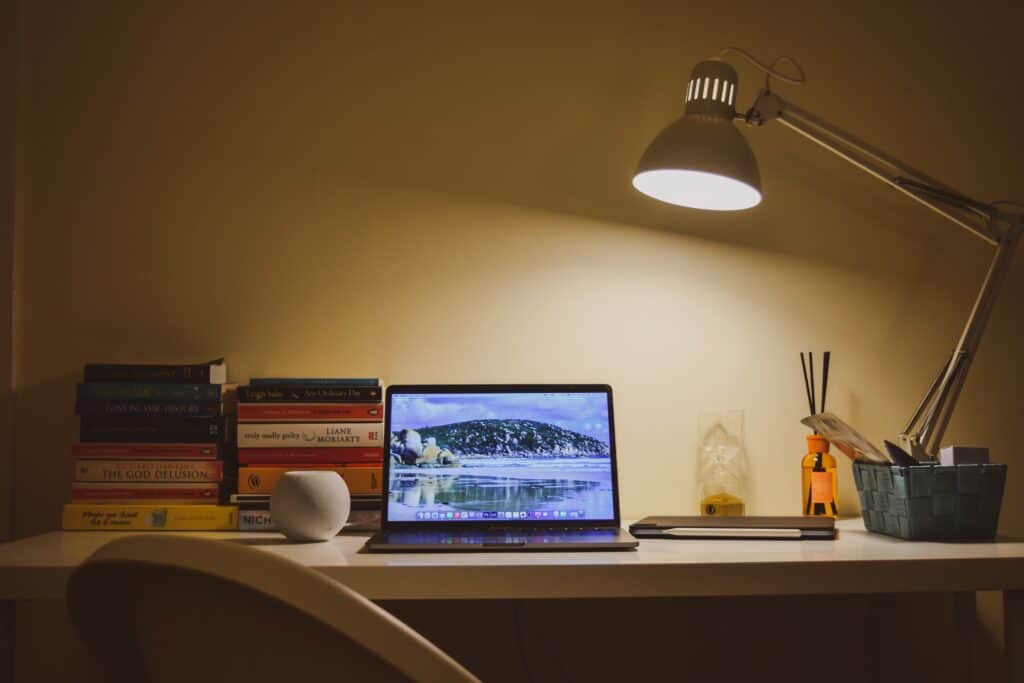
2. Color Temperature and CRI
Color temperature is another consideration in creating more natural lighting.
The color temperature ranges from 1000 to 10,000 kelvin; candlelight has a very low kelvin, while a clear sky has a higher kelvin.
The higher the Kelvin, the cooler it will be, and vice versa.
| Color Temperature | Feature |
|---|---|
| 2700K | Warmer white for warm skin tone |
| 3000K | Warm white for a more realistic skin tone |
| 4000K | Neutral Light with a slightly cold tone |
For video call setup, you should aim for anywhere between 2700k-6000k, mimicking natural sunlight.
Similarly, choose bulbs that offer maximum CRI for more color accuracy, over 90.
3. Brightness of the Light
A video call should be evenly lit so the participants can see your face. However, not much importance is given to the background; hence, you can leave the backdrop less bright.
Get LED light bulbs with 1600 lumens. Choose lesser lumens if you want a dimmer look.
Otherwise, you can look for the best lighting setup to create the required look.
Check whether your webcam is blurry to begin with.
Best Position to Setup Lighting for Zoom
Getting correct light fixtures only solves one problem; setting up the best lighting requires adjusting their position for the best outcome.
Here are a few tips to position your light for video calls on Zoom.
1. Put the Light Source in the Front
Cinematographers recommended positioning lighting in front instead of backlighting, which may create a mystical figure.
Always place the lamp, ring light, or ambient room light in front of you or slightly tilted to 45 degrees to give a bit of shadow on one side of the face.
Otherwise, you can tilt your laptop screen or phone sideways or vertically to get the right light.
2. Get fancy with Three-point Lighting
Three-point light refers to lighting the subject from three directions to create balanced depth and layers.
It is mainly adopted for filmmaking and professional interviews and relies on placing key light, fills light, and backlight around the subject.
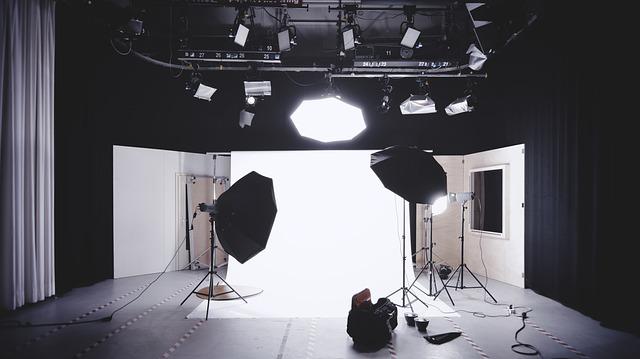
The fill light illuminates the space, while the key light illuminates the subject, and the backlight creates depth.
Here is a video tutorial on setting up 3-point lighting for video meetings.
4. Avoid Dark Shadows
Placing the light source behind or above the head will create shadows that may engulf your face.
You should always place the artificial light slightly farther from the face as a solution.
Additionally, increase the number of lighting fixtures or use high-lumen bulbs to eliminate the risk of dark shadows.
Here is a video tutorial about best lighting setup for Zoom to reduce shadows.
4. Add a White Bounce
Alternatively, you can use light clothing or material to bounce the light toward your face.
A principal concept of photography includes using a bouncer, bounce board, or cardboard to reflect the light toward the subject without harshness.
The white bounce provides the diffused light that makes your face look pleasant.
Here is a video highlighting the DIY tips for creating a home bounce board.
5. Do Not Forget the Screen
As you begin setting up the lighting position, do not forget to adjust the brightness of your screen.
The laptop or computer screen can be a significant light source, requiring adjustment according to artificial lights in the room.
Similarly, ensure that the artificial light does not shine on the screen to avoid glare.
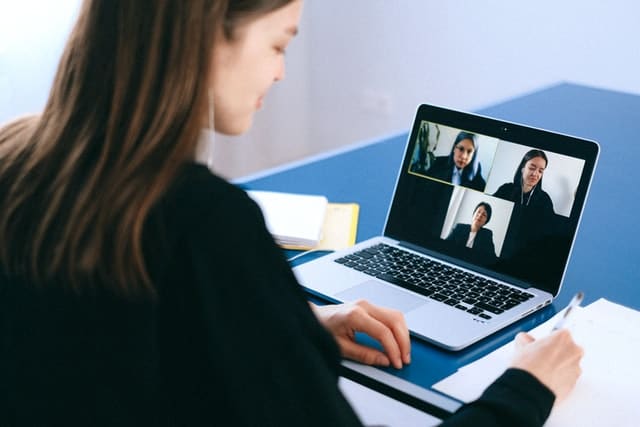
What to Avoid When Setting Up Lighting?
Ensure to avoid pitfalls when setting up the best lighting for Zoom that may look inappropriate or outright unprofessional.
1. Say No to Fairy Lights
Fairy or Christmas light is a holiday lighting fixture that creates a vibrant mood.
However, using them for Zoom calling may look unprofessional as they are inappropriate light sources.
Moreover, the light provided by fairy lights does not cast concentrated light enough for video calling.
2. Be Careful With Overhead Lighting
When placing an overhead lamp, ensure it does not create a shadow on your face.
Avoid placing it over your head when your only light source is a desk lamp.
Instead, place it facing your face or slightly tilted to create a slight shadow on your face.
3. Avoid Floor Lamps
Floor lamps are a highly concentrated light source that does not usually reach far enough.
Alternatively, they cast muted or filtered light because of the bulb’s shade.
Hence, avoid using floor lamps. Otherwise, add multiple floor lamps to create an evenly bright environment.
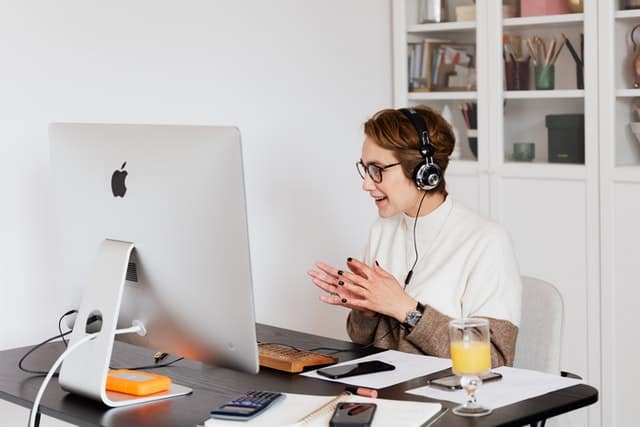
Conclusion
A small change in lighting can make a huge difference in how you look at video calls.
Whether video calling for a meeting or streaming live to your audience, choose appropriate lighting sources to create a professional look.
Experimenting with different lighting sources and positions is one way to know what works best.
Follow this guide to create the best lighting for Zoom and other video calls without worrying about looking worse.


